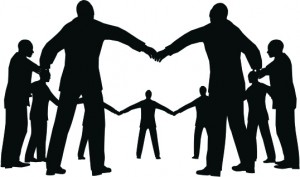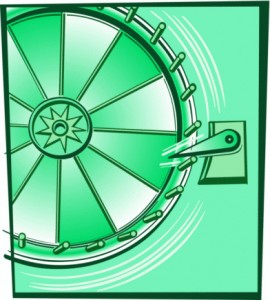Circus of Dreams (Part 5)
By Asher Crispe: November 21, 2012: Category Decoding the Tradition, Inspirations
To Light Up the Night
 One of the most basic models for Jewish society involves a threefold class distinction. Each class differs one from the next in terms of degrees of insider access, privileges and responsibilities. Taken together, the Cohanim (Priests), Leviim (Levites) and Yisraelim (Israelites) forge a single social vessel or ‘kli.’ Spelled Kaf, Lamed, Yud, the word for a vessel or container (kli) forms an acrostic that reflects the movement from the most highly circumscribed subset of the Cohanim (which begins with a Kaf) to the slightly broader tribe of the Leviim (which begins with a Lamed) and then to the full set of Yisraelim (which begins with a Yud). The all-inclusiveness of the group of three can been seen by the fact that they are alluded to in the word kli (vessel) which itself equals 60 or Samech. It’s all one giant social loop–one ‘support’ system (Samech once again means ‘support’). Along these same lines, we can now understand the significance of the sum total of ‘kosher’ witnesses at Mount Sinai having been 600,000 or 60 times 10,000. Even graphically the Samech hyperliterally defines the social ‘circle’ of Jewish associates.
One of the most basic models for Jewish society involves a threefold class distinction. Each class differs one from the next in terms of degrees of insider access, privileges and responsibilities. Taken together, the Cohanim (Priests), Leviim (Levites) and Yisraelim (Israelites) forge a single social vessel or ‘kli.’ Spelled Kaf, Lamed, Yud, the word for a vessel or container (kli) forms an acrostic that reflects the movement from the most highly circumscribed subset of the Cohanim (which begins with a Kaf) to the slightly broader tribe of the Leviim (which begins with a Lamed) and then to the full set of Yisraelim (which begins with a Yud). The all-inclusiveness of the group of three can been seen by the fact that they are alluded to in the word kli (vessel) which itself equals 60 or Samech. It’s all one giant social loop–one ‘support’ system (Samech once again means ‘support’). Along these same lines, we can now understand the significance of the sum total of ‘kosher’ witnesses at Mount Sinai having been 600,000 or 60 times 10,000. Even graphically the Samech hyperliterally defines the social ‘circle’ of Jewish associates.
In terms of praxis, each of these social classes functions in a relatively self-contained manner. Rigid social strata tend to operate within essentialistic definitions of self. We all occupy fixed places in society. However, for those familiar with role playing games, the inner dimensions of the Torah look at all of the social categories that are explicitly assigned to different kinds of individuals and inflect each one within all of the others. As a result, I get to play all of the roles on a psycho-spiritual level. While I will never be a Cohen on a literal level, I can locate the qualities of the Cohen within my inner world. In fact, everyone can inwardly perform the function of the Cohen spiritually by interiorizing all of our external experience. If it’s ‘out there,’ it’s ‘in here’ within me too.
This notion is reinforced by passages such as Exodus 19:6 where the part or subset of the people extends to supply qualities to the entire people (as if to say if some of us are like this then all of us can potentially be like this): “And you will be for Me a kingdom of priests (Cohanim), and a holy nation….” In the context of the verse, the subject of the address is the entire Jewish people. Everyone has a relative aspect of the ‘Cohen’ inside them. In the Talmud (Sanhedrin 59a), this idea is even extended to those who are not Jewish and who initially oppose the Torah by worshiping idols. As Rabbi Meir explains, “even a idolator who engages in Torah is like a High Priest (Cohen Gadol).” So everyone has some ‘Cohen’-like potential.
Given all of this build up, what is so exceptional about the Cohen? According to the plain meaning of the role, the Cohen are spiritual peace keepers. They conduct the services of the Temple (Beit HaMikdash) and facilitate the offerings etc…. Keeping in mind that the purpose of the Temple is to bring the people closer to the Divine (and to each other) by giving us a means to heal the rifts in our social and spiritual fabric. In light of this, we could say that the general overall spiritual service of the Cohen is one of transforming the negative into the positive. The process in the soul is one of ithafka (transformation) as opposed to the service of the Leviim which is the service of itkafia (submission or subjugation). In psychological terms, we can deal with negativity by suppressing it and holding it in check (the Levi does this according to Kabbalah) or more profoundly (and therefore more exceptionally) we can convert the negative from a force of opposition to something good that actually enhances our lives (the work of the Cohen). In the locution of the Zohar, this highest level of ithafka is depicted in terms of transforming darkness (in our context, the severe darkness of Kislev) into light (such as the light of Chanukah which was a victory and miracle that led to the kindling of the Menorah that was carried out by Cohanim.) In short, a person’s capacity to use all of the darkness in their lives as a fuel source for light creation is personified in the Cohen.
This transformative ability of the Cohen derives from the soul power of lovingkindness. When the Cohanim recite the Priestly Blessing they bless the people with ahavah (love). Love extends beyond existing definitions of self to allow personal transformation to occur. Love gives me room to change. If my assessment of self is in the dark–if my nature remains unclarified and undefined, then I can more readily redefine it. I trust that in the darkness of non-knowledge regarding myself, in the absence of perception into my own person, the Cohen within me can interpret that dream which is my life (which is itself within the larger dream of Creation or the world at large) and put a positive spin on it.
 Our Samech as a circle would seem to imply that it is a wheel of fortune. When I am having a downturn, there is always to potential for the wheel to continue to revolve until it turns up. It’s all about spin. The more undefined our reality, the more it’s in the dark, the easier it is to put spin on it. On the other hand, if I am like a deer in the headlights, the illumination freezes me in my tracks. I am defined by my place. Momentarily, while the spotlight of the analytic mind is upon me, I seem to have no room to maneuver. This kind of exposure leads to judgement as opposed to the non-judgmental orientation of love. My amorphous self can shape-shift in the dark. ‘I’ can spin and be spun. Subsequently, when the motivation of the spin doctor comes from love and seeks to heal, then the upswing will be truly redemptive. This is in part why Chassidim consider the month of Kislev as the month of redemption (geulah).
Our Samech as a circle would seem to imply that it is a wheel of fortune. When I am having a downturn, there is always to potential for the wheel to continue to revolve until it turns up. It’s all about spin. The more undefined our reality, the more it’s in the dark, the easier it is to put spin on it. On the other hand, if I am like a deer in the headlights, the illumination freezes me in my tracks. I am defined by my place. Momentarily, while the spotlight of the analytic mind is upon me, I seem to have no room to maneuver. This kind of exposure leads to judgement as opposed to the non-judgmental orientation of love. My amorphous self can shape-shift in the dark. ‘I’ can spin and be spun. Subsequently, when the motivation of the spin doctor comes from love and seeks to heal, then the upswing will be truly redemptive. This is in part why Chassidim consider the month of Kislev as the month of redemption (geulah).
Our discussion of the transformation of reality through the blessing of the Cohen and the interpretation of the dream of life continues in Part 6.
http://www.interinclusion.org/inspirations/circus-of-dreams-part-6/
http://www.interinclusion.org/inspirations/circus-of-dreams-part-4/
Circus of Dreams (Part 5) ,















;)
;)
;)
;)
;)
;)
;)
;)
;)
;)

These are all amazing articles, but if I could rate this one a six, I would. Incidentally, if you have a chance, look at how you’d spell kli in the language of the game we’re talking about. Thanks for writing these.